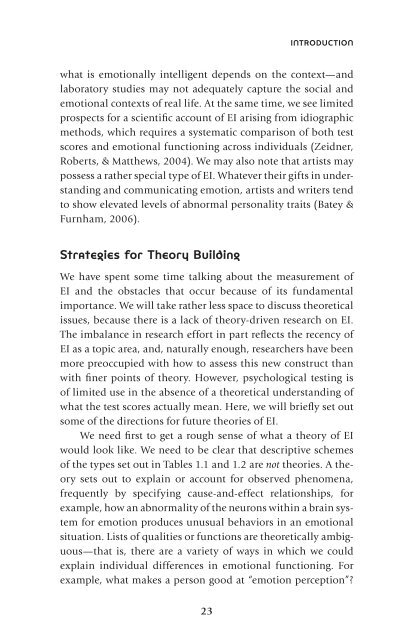Untitled - Springer Publishing
Untitled - Springer Publishing
Untitled - Springer Publishing
Create successful ePaper yourself
Turn your PDF publications into a flip-book with our unique Google optimized e-Paper software.
INTRODUCTION<br />
what is emotionally intelligent depends on the context—and<br />
laboratory studies may not adequately capture the social and<br />
emotional contexts of real life. At the same time, we see limited<br />
prospects for a scientific account of EI arising from idiographic<br />
methods, which requires a systematic comparison of both test<br />
scores and emotional functioning across individuals (Zeidner,<br />
Roberts, & Matthews, 2004). We may also note that artists may<br />
possess a rather special type of EI. Whatever their gifts in understanding<br />
and communicating emotion, artists and writers tend<br />
to show elevated levels of abnormal personality traits (Batey &<br />
Furnham, 2006).<br />
Strategies for Theory Building<br />
We have spent some time talking about the measurement of<br />
EI and the obstacles that occur because of its fundamental<br />
importance. We will take rather less space to discuss theoretical<br />
issues, because there is a lack of theory-driven research on EI.<br />
The imbalance in research effort in part reflects the recency of<br />
EI as a topic area, and, naturally enough, researchers have been<br />
more preoccupied with how to assess this new construct than<br />
with finer points of theory. However, psychological testing is<br />
of limited use in the absence of a theoretical understanding of<br />
what the test scores actually mean. Here, we will briefly set out<br />
some of the directions for future theories of EI.<br />
We need first to get a rough sense of what a theory of EI<br />
would look like. We need to be clear that descriptive schemes<br />
of the types set out in Tables 1.1 and 1.2 are not theories. A theory<br />
sets out to explain or account for observed phenomena,<br />
frequently by specifying cause-and-effect relationships, for<br />
example, how an abnormality of the neurons within a brain system<br />
for emotion produces unusual behaviors in an emotional<br />
situation. Lists of qualities or functions are theoretically ambiguous—that<br />
is, there are a variety of ways in which we could<br />
explain individual differences in emotional functioning. For<br />
example, what makes a person good at “emotion perception”?<br />
23<br />
Matthews_PTR_Ch 01_12-10-11_1-42.indd 23<br />
10/12/2011 10:46:54 AM
















